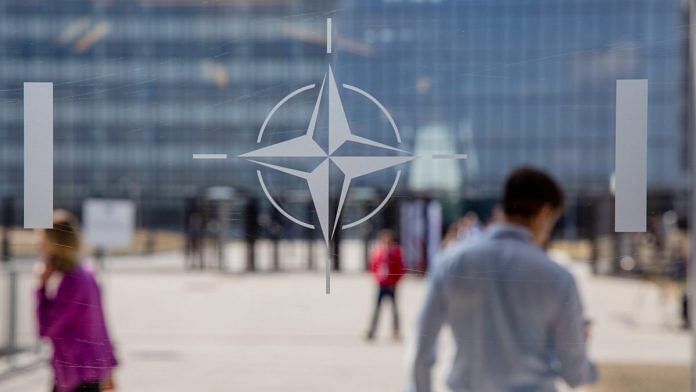New Delhi: Leaders of the North Atlantic Treaty Organisation (NATO) met Tuesday for a two-day summit in London to mark the alliance’s 70th anniversary. But everything isn’t well among the 29 member nations of the world’s most significant military alliance.
While the association is all about “collective defence” that is enshrined in Article 5 of the NATO Charter, a series of crises in the recent years have destabilised the alliance.
The tenets of NATO state that if any member nation faces an external attack, others are legally bound to come to its rescue. It also underscores that the US, as a superpower, is the chief guarantor of defence for all NATO members.
But since his election, US President Donald Trump has refused to overtly declare his commitment to Article 5, and has berated NATO allies for not meeting the defence spending targets. More recently, the invasion of Syria by Turkey, also a NATO member, has been another bone of contention among the leaders.
Last month, a third NATO crisis became a public spectacle. French President Emmanuel Macron, in an interview to The Economist, questioned if NATO’s collective defence commitments were still valid, and went on to say: “What we are currently experiencing is the brain death of NATO.”
Here is a brief look at how NATO has evolved in the last 70 years, and its current crisis under the Trump administration as well as a changing world order.
Also read: NATO threatens action if Russia doesn’t destroy its nuclear missile system
Formation of NATO
World War II began when Adolf Hitler’s National Socialist (Nazi Party) attacked Poland in 1939, driving Great Britain and France to declare war on Germany. Germany had allies such as Italy, Hungary, Bulgaria and Romania — together called the Axis Powers. The nations that fought the Axis Powers were called the Allied Powers.
In the post-war period, the European powers decided not to repeat another such conflict. But what soon emerged was the Cold War between two of the world’s largest powers — the Soviet Union and the US.
It was in the early stages of this Cold War that NATO was formed to “deter Soviet aggression” in Europe. Not surprisingly then that, throughout the period of this war, there was the US-led NATO alliance on one side and the Soviet Union-led Warsaw Pact on the other. The Warsaw Pact included Soviet-leaning Eastern and Central European nations.
According to historian Stanley Sloan, who is also a senior fellow at the think-tank Atlantic Council, the NATO was based on a transatlantic bargain between the US and Western European powers.
Former US president Harry Truman had then declared, “The determination of the free countries of Europe to protect themselves will be matched by an equal determination on our part to help them protect themselves.”
While the NATO was not involved in any operations during the Cold War, it has participated in major military conflicts since 1990. Some of its major operations have been during the 1990 Kuwait-Iraq war, the 1990s Bosnian war, 1999 Kosovo intervention, the ongoing Afghanistan war, 2003 Iraq war, and the 2011 Libya intervention.
Also read: NATO likely to declare space a war zone. This is how it could pan out
An existential crisis since 1991
The NATO also epitomised security guarantee by the US to its European allies, especially against the Soviet Union. After the collapse of the Soviet empire in 1991, NATO expanded further eastwards in Europe. Former East Bloc countries, which used to be under Moscow’s sphere of influence were welcomed into the NATO.
But the absence of the Soviet Union also deprived NATO of its key existential purpose – of stopping Soviet aggression.
“Since the USSR collapsed in 1991, the alliance has struggled to define a new purpose as unifying as that one,” writes Alex Kilment of Eurasia Group, a political risk consultancy.
Kilment further asked, “Is it meant to prevent Russia from doing to former Soviet-bloc NATO members what it’s done to Ukraine since 2014? Is it also a Western counter-terrorism bloc? Should it also focus more on the 21st century threat of cyberwarfare? Or is it enough that it’s a military alliance guaranteeing security and stability for the world’s two largest economic areas (North America and the EU)?”
Also read: As Trump goes back on commitments, nations wonder if US is still a reliable ally
NATO in the post-Trump world
While commentators have been asking difficult questions about the purpose and future direction of NATO since 1991, its problems have become more pronounced after Trump became the US President in 2017.
From the very outset of his presidency, Trump has publicly chided fellow NATO members for not spending enough on defence. According to the NATO Charter, all members are supposed to spend at least 2 per cent of their respective GDP on defence.
While the US has long held a grouse against European nations for not spending the stipulated amount, this is the first time when an American president is willing to sabotage the military alliance because of it.
Trump has even refrained from committing to Article 5 of the NATO Charter at successive summits. Article 5 entails a legally binding clause which states that an attack on one member state is an attack on all others. US’ support for Article 5 has been the cornerstone of NATO’s nuclear deterrence credibility in the post-war era.
Scholars have also argued that a direct consequence of the rise of President Trump is the weakening of NATO’s credibility in Europe vis-à-vis rising Russian aggression.
It is this kind of rising uncertainty regarding NATO, which led French President Macron to say: “(NATO) only works if the guarantor of last resort functions as such. I’d argue that we should reassess the reality of what Nato is in the light of the commitment of the United States.”
(Edited by Myithili Hazarika)
Also read: This is the case over which Trump sparred with US Navy chief Richard Spencer & fired him



